Fact 8: PCA Requires a Carefully Considered Diagnosis

Diagnosing PCA can be a complex process. It is a condition that, as of now, does not have a single, definitive test. The diagnosis is usually a result of careful examination of the symptoms, a comprehensive review of the individual’s medical history, cognitive assessments, and neuroimaging studies.
The diagnosis begins with a careful assessment of the individual’s symptoms. Due to PCA’s unique manifestation – the visual disturbances – it can often be mistaken for an eye disorder initially. However, as eye tests come back normal and cognitive assessments reveal distinct abnormalities in spatial cognition, object recognition, and other visual tasks, the possibility of PCA is considered.
Medical history is also a crucial component of the diagnosis. As PCA is typically an early-onset condition, affecting people in their mid-50s to early 60s, a younger patient presenting with such symptoms might raise suspicion of PCA. Additionally, a history of progressive visual disturbances with preserved memory and verbal abilities also points towards PCA.
Neuropsychological assessments are used to understand the extent and nature of cognitive impairment. People with PCA tend to perform poorly on tasks involving visuospatial skills and object recognition, even though their memory and language abilities remain largely intact. This pattern of cognitive impairment further supports the suspicion of PCA.
Finally, neuroimaging studies, such as MRI, can be instrumental in diagnosing PCA. They can reveal a characteristic pattern of atrophy, particularly in the parietal and occipital lobes of the brain – areas involved in visual processing. The combination of symptoms, cognitive assessments, and imaging studies can help in arriving at a PCA diagnosis. (8)